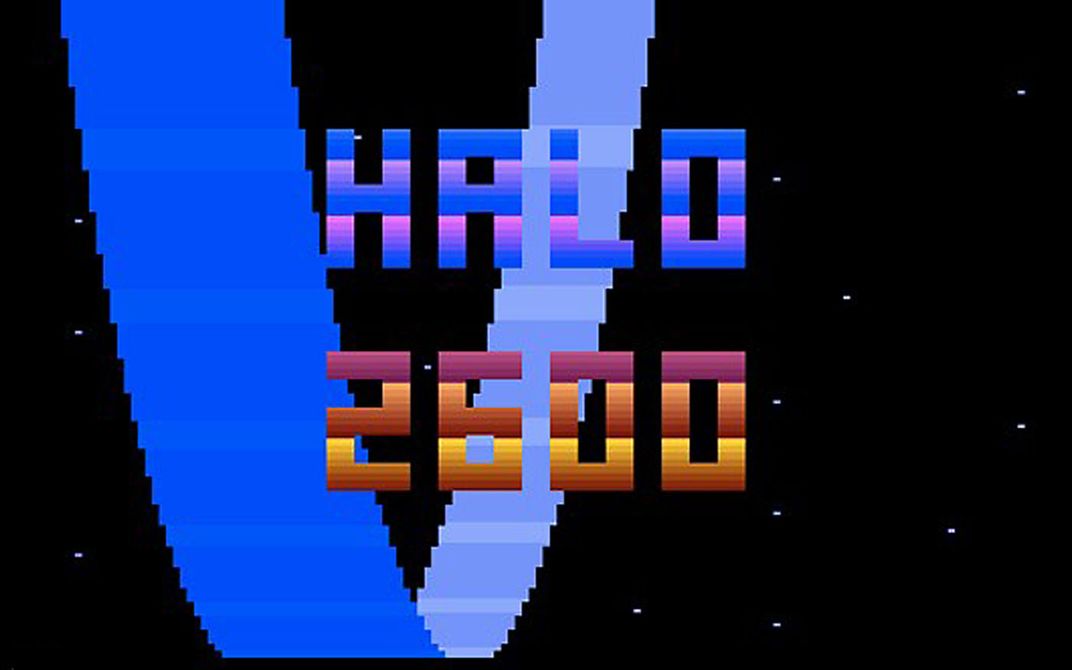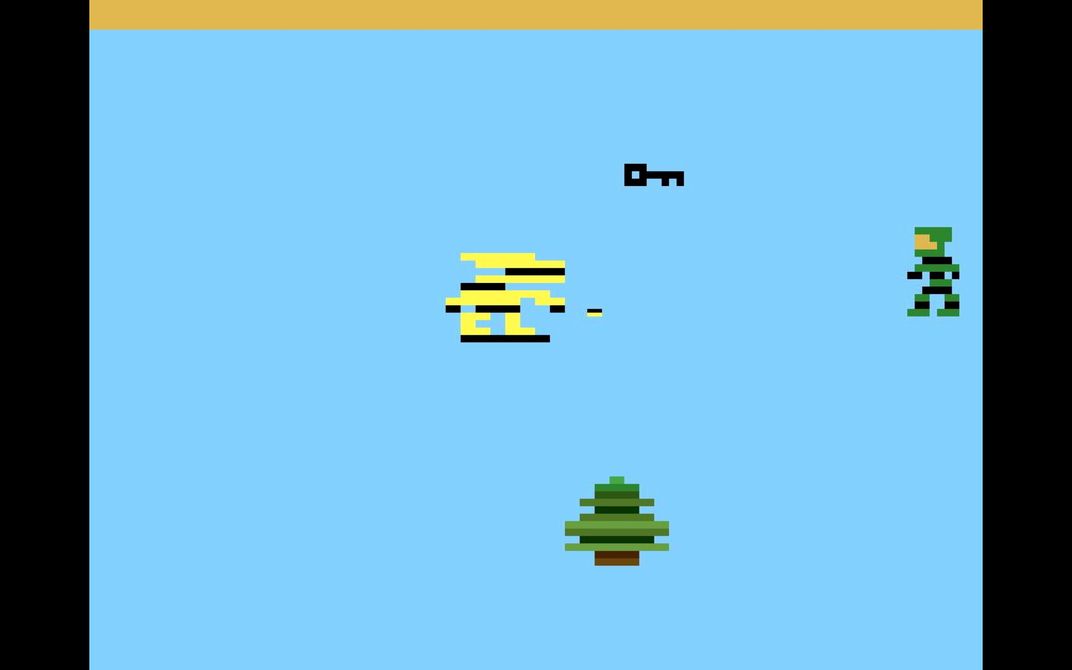Demaking Halo, Remaking Art: ‘Halo 2600’ Developer Discusses the Promise of Video Games
Ed Fries talks with Smithsonian magazine about programming the Atari 2600 and shaping the future of interactive media.
:focal(942x757:943x758)/https://tf-cmsv2-smithsonianmag-media.s3.amazonaws.com/filer/1c/ea/1cea5887-5058-4acc-b192-23623c67dbc1/111202edfries.jpg)
Demaking a video game, says Ed Fries, is "like haiku" for programmers, an exercise in "enforcing constraints on yourself as a tool for creativity." Everyone knows remakes, fortunes have been made on the backs of franchises like Mario, Sonic and Call of Duty. But to demake a game, to adapt a concept to an older, less-capable hardware, is a curiously demanding challenge.
In 2010, Fries, a former vice president of game publishing at Microsoft, released a landmark demake, Halo 2600—a version of Halo, the multibillion-dollar series that has dominated 21st-century gaming—for the Atari 2600, the 1970s vintage console that brought us Pac-Man. Now, Halo 2600 has been added to the Smithsonian American Art Museum's permanent collections. A playable version will go on display at a date yet to be determined.
After reading a book about programming for the 1970s Atari 2600 video-game console, Fries decided to try his hand at writing some of his own code for the vintage console. Fries recreated the game's protagonist "Master Chief," a cybernetically-enhanced super soldier, not intending to recast the entire game. But subsequent conversations with other developers inspired him to to complete the project.
The final result? Fries ended up compressing “Halo” into a distilled, two-dimensional game featuring its original key plot elements—while using only 4KB of memory. In doing so, the programmer reimagined a modern blockbuster game as it would be played through the early technology responsible for launching the entire video game industry—a process akin to fashioning a space shuttle out of Model T parts.
At first glance, Halo 2600 might seem more suited for an arcade than an art museum. But this isn't the first time the museum has featured games as art: Halo 2600 was one of several selected for display in the popular 2012 exhibition, “The Art of Video Games.” And now that the game is a permanent part of the museum's treasure trove of interactive media, Michael Mansfield, curator of the film and media arts, already has his eye on others.
"I think that a significant amount of artists are working with interactive mechanics and things of this nature," says Mansfield. "We’re paying very close attention to what the game industry is doing, and to what gamers are doing."
In a nod to the museum's expanding media arts collection, Smithsonian magazine spoke to Fries about the future of video games, how programming's changed over the past 35 years, and how he feels about being called an "artist.''
I read somewhere that you said that people who grew up playing the Atari would care about Halo2600, but probably nobody else would. How does it feel now that curators consider it “art” and are archiving it in an art museum?
I never thought of myself as an artist. I guess, about is what was interesting—it’s more what I learned while I was making the game that maybe makes it more like art than just another programming project.
What did you learn?
Well… it’s the basics of a longer talk that I gave about the experience and about what it was like to program, to go back to one of these old machines, and program under a considerable constraint. As a programmer over the last 30 to 35 years, machines have gotten bigger and bigger and bigger, and there’s been more and more and more memory, and it’s changed the way you think of making a program.
So to go back to one of those old machines, where just to put it in perspective, there’s about a million times less space for the game on Atari 2600 than there would be on the first version of Halo for Xbox. And probably I don’t know, four million times less RAM space or something like that. So it’s incredibly small.
I would compare it to the difference between writing a book and writing a poem. So if you’re writing a book, you’ve got all the space you need, right, and you can kind of just write in a very freeform way, put your sentences together, until you tell the story that you want to tell. But in a poem you’re under some really tight constraints, you know? You have a limited amount of space, and even within the lines of that space you have to follow really specific rules. I mean, there’s typically a meter and a rhyme, and all of these things affect the way you express yourself.
And so going back and working on this machine was going from a novel to writing a poem or writing a haiku. Everything had to be carefully chosen, and everything had to be compressed. But also, there’s sort of serendipity that comes out in that act. . . . Because of the constraints that you’re under, words present themselves that wouldn’t otherwise. I mean, you can’t choose the words that you might not want to choose because it doesn’t fit with the meter, or it doesn’t fit with they rhyme. And so you have to choose a different word, and that takes you off in different direction than maybe you thought when you were setting off to create the poem in the first place.
I found these kinds of feelings happening to me while I was programming this game, and that got me thinking of that whole idea of artificial constraints, or enforcing constraints, on yourself as a tool for creativity—as a way to take you in new directions that you wouldn’t normally expect.
With video games being such a young medium, I think it’s silly to say there are no more good ideas. But the business of games is kind of like Hollywood sequels—adaptations, safe bets. Is that at odds with art? Can video games still be daring without conforming to established genre tropes?
It’s actually an incredibly exciting time in the game business. . . .I think all parts of the game business are pushing the boundaries, artistically. So you have kind of the big blockbusters, and you think well, yeah, there are sequels, you know, they have to be somewhat predictable because they have to sell millions of copies. But really, they’re at the forefront of trying to make video games a narrative art form in a sense that they’re competing with something like movies in telling a story with characters in a way that’s believable—believable dialogues, believable characters, believable emotion. So at the high end, they’re really pushing that production value. It’s kind of an exploration—can we make a game that makes you feel things as strong, or stronger, than a great movie would make you feel?
But then underneath that, you have a huge upswell of indie games. It used to be hard to make a game. It used to be only kind of programmers like myself would make them. And we come at it from a certain perspective, I think. But now there are new tools that are available—one is a very popular one, it’s called Unity—and Unity makes it easier than ever for just about anyone to make a video game. And so that’s, I think, opening the medium up to more artistic creations. And so just seeing the whole series of fantastic art games kind of coming out— a dad made a game called “That Dragon, Cancer,” recently, about his experience with one of his four sons having cancer. There’s another award-winning game that was developed in the last year called “Gone Home,” which is about a relationship between two young women in high school. And these are topics that never would’ve been touched by the video game business in the past. It’s like, ‘Wow, you can make a video game about that?” I could see that you could make a book about it, or a movie, but a game? It’s really the changing face of who can make games, how games are made. And, you know, that’s opening the medium up for exploring every human topic.
I read that Roger Ebert argument from way back in which he said that video games aren't art because they haven't been compared to the greatest poems or songs. I know there's always a lot of debate surrounding the artistic evolution of a new medium; do you think someday there will be a game on par with the greatest plays, poems and songs in terms of pure conceptual art or evoking emotion?
I think even Ebert stepped back from his initial statement to some degree. And … absolutely. Absolutely. I don’t see why not. I think games can be a more powerful medium because we put the player in control, and that’s really what’s different about video games—or sometimes what we call it, interactive entertainment—because you really feel like you’re there, you’re in that situation, you have some control over the outcomes that you’re making decisions about.
Also, that’s also the biggest challenge of video games, artistically, at least from a narrative point of view. How do you give player control, or at least a sense of control, while still taking them where you want to take them, while still telling the story that you want to tell? So it’s a much more fluid relationship between the audience and the artist. And you know, that’s a hard problem. That’s why it’s taken games 35 years to get where we are today, and why we still have a lot of work to do. But I think we’re getting better about it.
I don’t want to get too caught up in "Art" with a capital A in a sense, because then it becomes this whole kind of pointless argument about what is art to begin with. I think what matters is, can we tell human stories in a way that affect people—maybe change how they feel about themselves, or the world or exposes them to something that they haven’t been exposed to before? And in the game business, that simple thing is actually pretty hard. I mean, it’s taken us many years and a lot of technological advance to be able to make realistic characters on a screen that look like people, that don’t look like robots, that move like real people, that when they talk, the way their mouths move or eyes sparkle. You know, that doesn’t make you feel like you’re looking at a puppet—that makes you feel like you’re looking at a real human being. Once you get past that, then you open up the door to tell real stories about real people but in a way that’s different than a movie because the player’s in control. And that’s the promise for video games.
Anything else you want to add—about video games, about the Smithsonian, about art ?
I’ve worked in the game business for a long time on stuff both big and small, and it’s just been really fun to see the business evolve over the years. And so going to that video game exhibit at the Smithsonian American Art Museum, and being able to take my family and my two young boys—it was just a fantastic experience, and it reminds me how far we’ve come in 35 years.
/https://tf-cmsv2-smithsonianmag-media.s3.amazonaws.com/accounts/headshot/Fawcett-Bio.jpg)




/https://tf-cmsv2-smithsonianmag-media.s3.amazonaws.com/accounts/headshot/Fawcett-Bio.jpg)